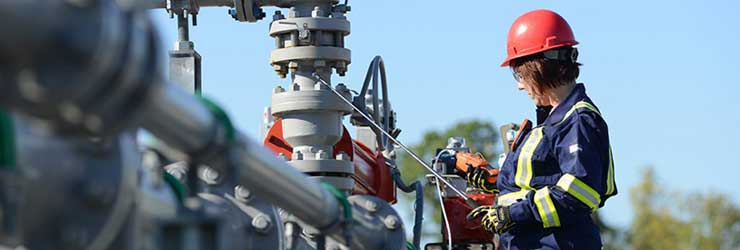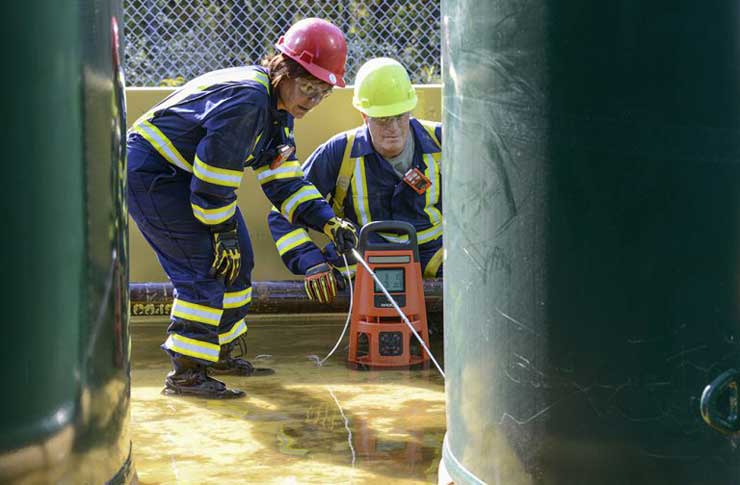
Some people believe a gas detector with pump is far better – that no pump means less accuracy, slower response, and it simply won’t detect as much gas. FACT: A gas detector with pump doesn’t mean it is more accurate, responds quicker or covers more area around you. But it will make some tasks much easier and safer.
Exactly when and how pumps should be used is a common topic.
Why use a pump with a gas detector?
Gas detectors with pumps allow you to easily pull air from an unknown and potentially toxic or combustible atmosphere to your location. You can then view the monitor’s results in an area you know to be safe.
Pumps literally keep you out of harm’s way.
Once you’ve assessed the air sample using a gas detector with pump and confirmed it is clear of any toxic or combustible gases, you can safely enter the tested area.

Pumped gas detectors keep you out of areas where potentially harmful gases may be lurking.
It is not uncommon for a vessel to be low and 10+ metres long. In this type of confined space entry, a pump with an extendible probe allows you to slowly advance into the space with the probe ahead of you. This ensures the atmosphere is safe prior to entry.
Other times, the vessel may be tall and narrow, requiring entry from above. Using a gas detector with pump and tubing allows you to check from above that the entire vessel is completely empty of any hazardous gases prior to entering.
In both examples, you allow the pump and sampling equipment to pull the air to the gas detector prior to entry, making the operations safer.
We’ve seen how a gas detector with pump can make operations easier and safer. However, having a pump doesn’t increase the range of detection or effectiveness of the gas detector.
Whether you have a gas detector with pump or a non-pumped gas detector, the sensors will only detect the gas they come in direct contact with.
Having a pump on a gas detector does not increase the amount of gas the sensors see. Rather, the pump allows you to test the atmosphere at a distance from the gas detector.
Therefore, if you place two gas detectors side by side, one having a pump with no tubing attached and the other a non-pumped gas detector, both will detect the hazardous gases just as fast. Both will read the same.
What is the downside of using a gas detector with pump?
While a gas detector will detect gas in the same manner, whether it has a pump on it or not, a gas detector with pump will certainly be larger and heavier.
Also, the pump will use some of the gas detector’s battery, resulting in a shorter run time. Since workers typically wear a gas detector their entire workday, which could extend to 12+ hours, having a gas detector that is small, lightweight and runs the entire shift is critical.
Most people would agree that it is better to save the gas detector with pump for where it is absolutely needed.
Other considerations when using a gas detector with pump
Once you have decided a pumped gas detector is needed, you’ll want to make sure you have the necessary accessories to use and protect your pumped detector.
If you’re doing a horizontal entry or using the pump to check areas that are difficult to reach, you’ll want to use a probe. This may be a lightweight polycarbonate probe, an extendable stainless steel probe, or perhaps a probe designed to withstand high temperatures.
If you are doing a vertical entry, you’ll need need some tubing. You will most commonly see urethane and Teflon-lined tubing used.
Urethane tubing is suitable to sample gases with the exception of chlorine, chlorine dioxide, hydrogen chloride, and volatile organic compounds (VOCs), which can be absorbed by urethane tubing, leading to inaccurate readings. Teflon-lined tubing is therefore recommended for use with these gases.
Any time you use a gas detector with pump and tubing, it is important to allow enough time for the gas sample to travel the length of tubing and diffuse into the sensors.
A good rule of thumb is 6 seconds per metre of tubing, plus 2 minutes for the sensors to read and stabilise.
That means if you have 10 metres of tubing attached to your pump, it will be 3 minutes before you will get readings from the gas at the end of that tubing.
Another important tip when using a pumped gas detector is to use a dust filter and water stop at the end of the tubing or probe. In addition to preventing damage from dust and debris, it will prevent liquid from being pulled into the pump motor should the end of the tubing get dropped into any liquids.
Whether you are working in a water treatment plant and verifying that a tank is free of gases prior to its maintenance, or checking for leaks among a number of hard-to-access valves and piping in a refinery, using a gas detector with pump will keep you out of harm’s way.
For personal gas detection applications where remote sampling is not required, consider sticking with a non-pumped gas detector.
If you’d like to enquire about pumped gas detectors, here’s what to do…
- Email gas@entec.co.nz, or
- Phone (06) 758-3030 ext 2 to talk to a gas detection expert.
A version of this article first appeared at indsci.com here. Revised and republished with permission.